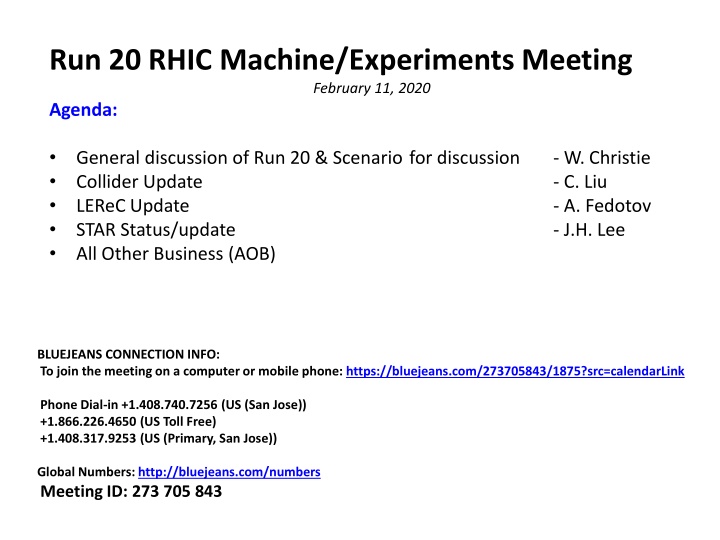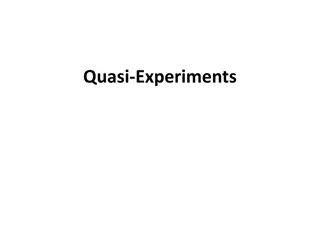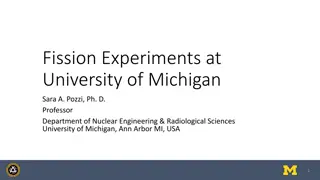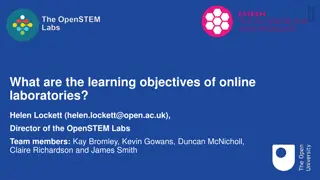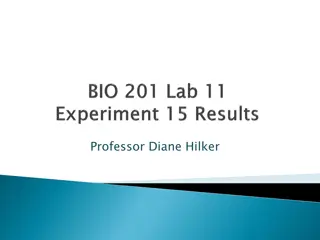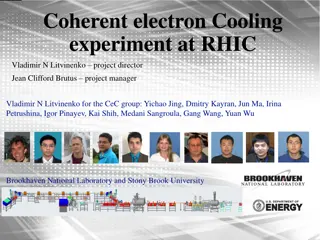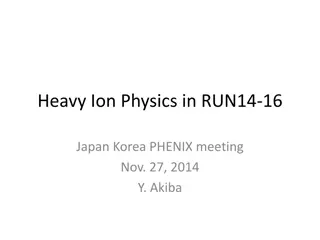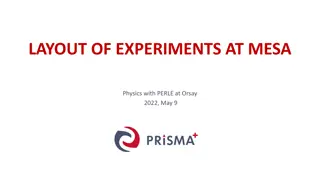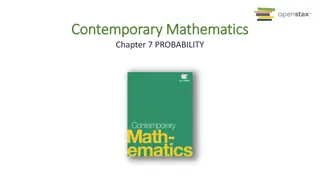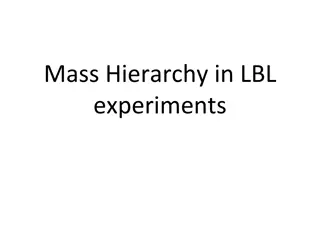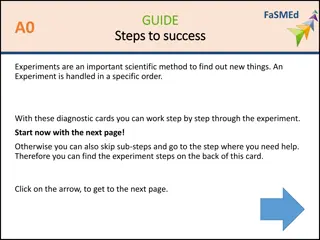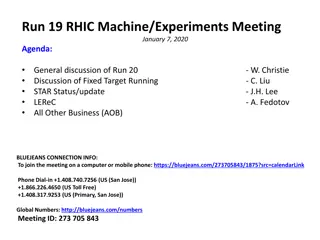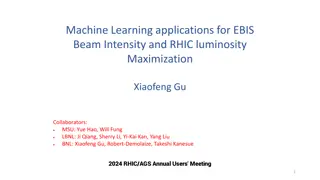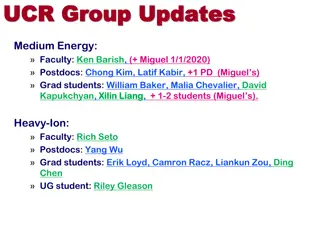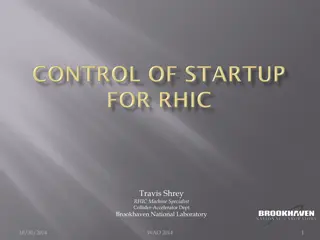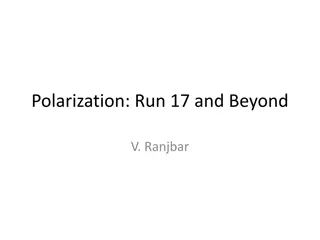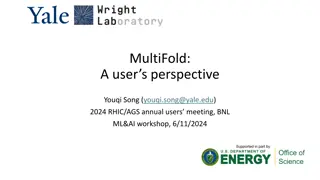Run 20 RHIC Experiments Meeting Summary
Agenda and updates from the Run 20 RHIC Machine Experiments Meeting held on February 11, 2020, including discussions on collider updates, LEReC, STAR status, interleaving LEReC commissioning with STAR physics running, and estimates for data collection.
Download Presentation

Please find below an Image/Link to download the presentation.
The content on the website is provided AS IS for your information and personal use only. It may not be sold, licensed, or shared on other websites without obtaining consent from the author.If you encounter any issues during the download, it is possible that the publisher has removed the file from their server.
You are allowed to download the files provided on this website for personal or commercial use, subject to the condition that they are used lawfully. All files are the property of their respective owners.
The content on the website is provided AS IS for your information and personal use only. It may not be sold, licensed, or shared on other websites without obtaining consent from the author.
E N D
Presentation Transcript
Run 20 RHIC Machine/Experiments Meeting February 11, 2020 Agenda: General discussion of Run 20 & Scenario for discussion Collider Update LEReC Update STAR Status/update All Other Business (AOB) - W. Christie - C. Liu - A. Fedotov - J.H. Lee BLUEJEANS CONNECTION INFO: To join the meeting on a computer or mobile phone: https://bluejeans.com/273705843/1875?src=calendarLink Phone Dial-in +1.408.740.7256 (US (San Jose)) +1.866.226.4650 (US Toll Free) +1.408.317.9253 (US (Primary, San Jose)) Global Numbers: http://bluejeans.com/numbers Meeting ID: 273 705 843
N.B. The Schedule above assumes that RHIC Run 2020 will be 28 Cryo weeks long. The actual transition date between 11.5 and 9.2 GeV Physics running will be a matter of discussion as the run progresses.
Summary of interleaving LEReC Commissioning with the STAR Physics running Meeting held on December 17, 2018 to discuss Strategy/plan: - Once collisions available, Spend the first about week getting STAR tuned up and the Physics running going. - After this first week of running, start interleaving LEReC commissioning - Idea discussed to schedule for 12 hours every other day (e.g. M, W, F) - Keep schedule flexible so that if for any reason LEReC can t effective use the time it switched back to Physics running. - Also so that if LEReC is making good progress, and more time is desirable, the allotted time can be extended. This is a Strategy/plan to get started on this sharing of the Collider time. Expectation is that once we see how this works we ll discuss if we need any modifications. Rough accounting of LEReC hours per week (Run 20) and planned for this week: 12/10 - 12/16: ~20 hrs LEReC 12/17 - 12/23: 28 hrs LEReC 12/24 - 12/30: 0 hrs LEReC 12/31 1/6: ~24 hrs LEReC 1/7 - 1/13: ~ 31 hrs LEReC 1/14 1/20: ~ 33 hrs LEReC 1/21 1/27: ~ 32 hrs LEReC 1/28 2/3: ~ 28 hrs LEReC Total LEReC ~ 196 hrs (~ 8.2 days) Done Key: Blue = as run Red = planned
~ 132 Mevts at present ~ 7 Mevts at present Done Done Done Done Done STAR s plan is to accumulate 100 Mevts this year for each of the 6 FXT energies. Rough estimate of STAR running time needed per Energy is ~ 16.5 hrs. - assumes average HLT good rate of 1700 Hz - Only one fixed target data set left (5.75 GeV, sched. To start 2/13) Slide from the 12/3/19 STAR Time mtg presentation
Some STAR Trigger rates with 9.2 GeV LEReC Cooled Collisions Rates seen on Sunday, February 9, 2020. Good evts
Updated estimates for how long it would take to collect the 9.2 GeV data set Good evt rate Store Lengths DAQ Hrs/Day Estimates based on observed performance: Good evts/day If one assumes 15 Hrs/day of DAQ running, at an average rate of 3 Hz: - 15 hrs/day x 3600 sec/hr x 33 evts/sec = 1.8 Mevts/day - Data set goal is 160 M good evts (Currently have 7 Mevts) - 153 Mevts/1.8 Mevts/day = 85 days = 12.4 wks Reasons to believe that the estimate above is realistic: On Sunday, after only a few days of optimization, 2 M good evts were recorded There was a store that had an average good event rate of 38 Hz Historically, the RHIC luminosity takes weeks of running to reach luminosity plateau - - -
An extremely successful return to collisions at 11.5 GeV Good evt rate Good evt rate increased, and the input min-bias trigger rate decreased! Cleaner data at a higher rate! Estimate for how long it might take to complete the 11.5 GeV data set: - 131 M good evts in hand - Goal is 230 M good evts (~ 100 Mevts to go) - 9.2 GeV LEReC interleaved commissioning is done. - Use assumptions of 15 hrs/day of DAQ running, and store averaged good evt rates of 90 Hz - 15 hrs/day x 3600 sec/hr x 90 evts/sec = 4.9 Mevts/day - 100 Mevts/4.9 Mevts/day = 20.4 days - There are 20 days between today and Monday March 2nd - I judge the estimate above as somewhere between realistic and conservative
A possible Scenario for how the rest of Run 2020 might proceed We went back to 11.5 GeV Physics running on Monday February 10th, estimate is that we ll complete 230 Mevts goal by Monday, March 2nd. If 9.2 GeV Physics running is from March 2, to May 25, this is 12 wks. With observed rates for 9.2 GeV collisions this should be sufficient time to reach full 130 Mevts goal. 2 weeks of 7.7 GeV LEReC commissioning gets one to June 8th. This may be an overestimate of the LEReC time needed. 8 days of CeC then gets one to June 15th, the end of a 28 Cryo week run (N.B. assumption of 28 Cryo week run. N.B. The 9.2 Gev Physics running, 7.7 GeV LEReC commissioning, and CEC time may well be run in an interleaved mode from March 2 to the end of the run.
